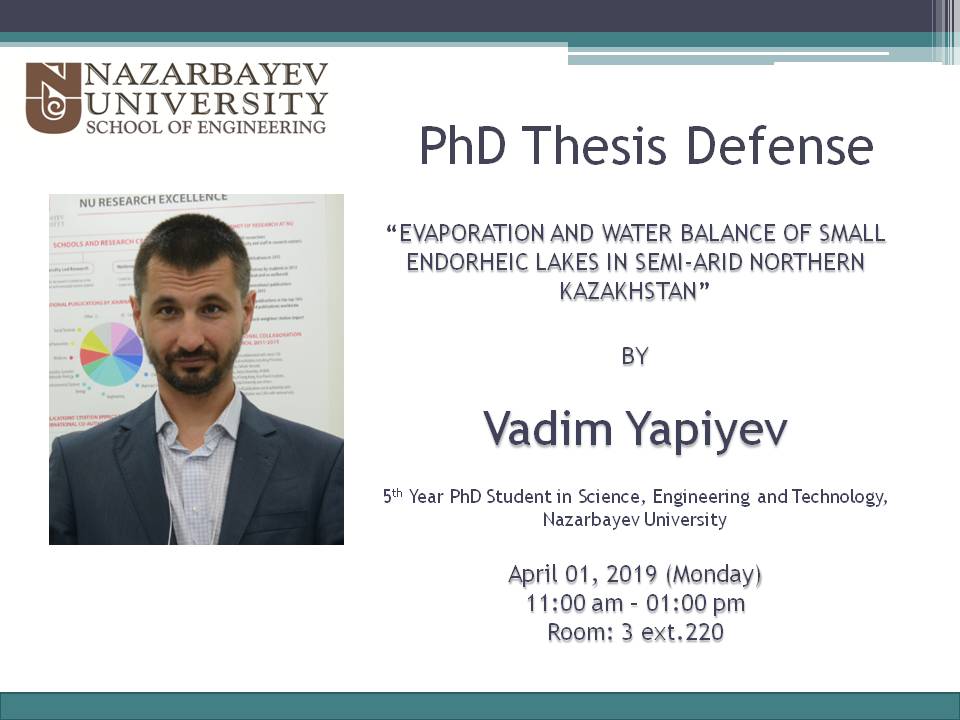PhD Thesis Defense at the School of Engineering

Nazarbayev University’s PhD Program in Science, Engineering and Technology is delighted to invite you to the PhD Thesis Defense:
Candidate: Vadim Yapiyev, 5th-year PhD student
Thesis Title: «EVAPORATION AND WATER BALANCE OF SMALL ENDORHEIC LAKES IN SEMI-ARID NORTHERN KAZAKHSTAN».
Lead Supervisor: Professor Jay Sagin, Dept. of Civil and Environmental Eng., School of Engineering, Nazarbayev University, Kazakhstan
Co-Supervisor: Professor Christian Schönbach , Department of Biology, Nazarbayev University, School of Science and Technology, Nazarbayev University, Kazakhstan
Co-Supervisor: Professor Vassilis Inglezakis, Dept. of Chemical and Materials Eng., School of Engineering, Nazarbayev University, Kazakhstan
External Supervisor: Professor Anne Verhoef, Department of Geography and Environmental Science, University of Reading, UK,
Chair-Internal Examiner: Professor Luis Rojas-Solórzano, Dept. of Mechanical and Aerospace Eng., School of Engineering, Nazarbayev University, Kazakhstan
Internal Examiner: Professor Ferhat Karaca, Dept. of Civil and Environmental Eng., School of Engineering, Nazarbayev University, Kazakhstan
External Examiner: Professor Michiaki Sugita, Professor of Hydrology (Research Unit on Hydrologic Science), Faculty of Life and Environmental Sciences, University of Tsukuba , Japan
Abstract
Approximately two thirds of global precipitation falling over continental surfaces is reverted to the atmosphere by terrestrial evaporation. Over the terrestrial surfaces, the difference between Precipitation-Evaporation (P-E) is stored as soil- surface- and groundwater and contributes to surface and sub-surface runoff that ultimately returns water back to the ocean by stream and groundwater flow.
Endorheic basins (i.e., closed or terminal basins) and lakes are land locked drainage networks where water does not drain into large water bodies, such as rivers connected to oceans. The level of evaporation (E) is generally higher than precipitation (P) for basins in arid and semi-arid areas, where most of these basins and lakes are located. In contrast to endorheic systems, exorheic systems are connected to the sea. Typically, these basins have relatively abundant precipitation and balanced P–E terms. The existence of Endorheism-Exorheism is controlled by climate on geological time scales.
Most of the endorheic lakes in the world have experienced a decline in water storage during the past decades. This deterioration of water storage concerns both large enclosed inland seas, such as the Aral and Caspian seas, as well small and medium endorheic lakes in arid and semi-arid climates. These drops in water levels are frequently attributed to an increase in open water evaporation in a warming climate.
Kazakhstan is an inland country of the Eurasian continent with scarce water resources. Thus far, the hydrological cycle of the semi-arid Northern Kazakhstan region has not been researched extensively. The focus of this thesis is Burabay National Nature Park (BNNP), a relatively small unique ecological zone located in the northern part of Kazakhstan. It consists of several small endorheic lakes within catchments with a dominant land cover of semi-arid mixed forest and grassland. The park is located on the southern edge of Northern Eurasia where energy-limited boreal forests transcend into water-limited steppe. The water levels of these lakes have experienced dramatic fluctuations during the past century and the lakes have a tendency to dry up. This has detrimental ecological consequences, but it also adversely affects tourism in the area. Unfortunately, before this investigation the components of the hydrological cycle for these watersheds and lakes have not been properly monitored and quantified. Thus, this work aims to provide a scientifically sound assessment of water storage changes in these small lakes to distinguish the effects of climate change and direct anthropogenic influences.
In framework of the thesis, a methodology was developed for the estimation of lake evaporation using simple micrometeorological equations, gridded atmospheric reanalysis and in-situ lake surface temperature. This allowed for the construction of a long-term (30 years, monthly) and medium-term but high-frequency (9 years, daily) time-series of lake evaporation and reconstruction of water balance for three lakes in a geographical area for which such data have not been shown before.
Though the problem is not new, the approach implemented in this work includes a blend of different measurement and modelling methodologies: 1) Remote Sensing and Geomatics, 2) Hydrometeorology and Physical Hydrology, 3) Stable Water Isotopes, 4) Environmental Physics and Micrometeorology. All these methods and approaches are used to holistically address the research objectives. The work is centered on one of the key and fundamental questions of modern hydrology: What is evaporation (its rate and controlling factors), and how are its values shifting in a changing climate? Though the work presented has a local focus, it is ultimately embedded in a global and regional (Central Asia) context.
Date and time: April 1, 2019 (Monday) at 11:00 am, room 3e.220



